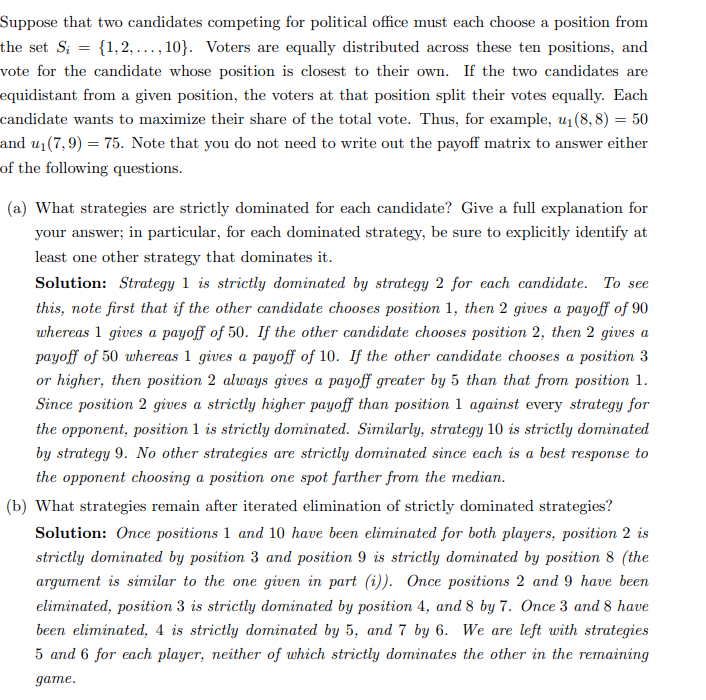he set S; = {1,2,..., 10}. Voters are equally distributed across these ten positions, and ote for the candidate whose position is closest to their own. If the two candidates are quidistant from a given position, the voters at that position split their votes equally. Each andidate wants to maximize their share of the total vote. Thus, for example, u₁(8,8) = 50 nd u₁(7,9) = 75. Note that you do not need to write out the payoff matrix to answer either f the following questions.
he set S; = {1,2,..., 10}. Voters are equally distributed across these ten positions, and ote for the candidate whose position is closest to their own. If the two candidates are quidistant from a given position, the voters at that position split their votes equally. Each andidate wants to maximize their share of the total vote. Thus, for example, u₁(8,8) = 50 nd u₁(7,9) = 75. Note that you do not need to write out the payoff matrix to answer either f the following questions.
Chapter1: Making Economics Decisions
Section: Chapter Questions
Problem 1QTC
Related questions
Question
PLEASE CHECK THIS HOW TO SOLVE

Transcribed Image Text:Suppose that two candidates competing for political office must each choose a position from
the set Sį = {1,2,..., 10}. Voters are equally distributed across these ten positions, and
vote for the candidate whose position is closest to their own. If the two candidates are
equidistant from a given position, the voters at that position split their votes equally. Each
candidate wants to maximize their share of the total vote. Thus, for example, u₁(8,8) = 50
and u₁(7,9) = 75. Note that you do not need to write out the payoff matrix to answer either
of the following questions.
(a) What strategies are strictly dominated for each candidate? Give a full explanation for
your answer; in particular, for each dominated strategy, be sure to explicitly identify at
least one other strategy that dominates it.
Solution: Strategy 1 is strictly dominated by strategy 2 for each candidate. To see
this, note first that if the other candidate chooses position 1, then 2 gives a payoff of 90
whereas 1 gives a payoff of 50. If the other candidate chooses position 2, then 2 gives a
payoff of 50 whereas 1 gives a payoff of 10. If the other candidate chooses a position 3
or higher, then position 2 always gives a payoff greater by 5 than that from position 1.
Since position 2 gives a strictly higher payoff than position 1 against every strategy for
the opponent, position 1 is strictly dominated. Similarly, strategy 10 is strictly dominated
by strategy 9. No other strategies are strictly dominated since each is a best response to
the opponent choosing a position one spot farther from the median.
(b) What strategies remain after iterated elimination of strictly dominated strategies?
Solution: Once positions 1 and 10 have been eliminated for both players, position 2 is
strictly dominated by position 3 and position 9 is strictly dominated by position 8 (the
argument is similar to the one given in part (i)). Once positions 2 and 9 have been
eliminated, position 3 is strictly dominated by position 4, and 8 by 7. Once 3 and 8 have
been eliminated, 4 is strictly dominated by 5, and 7 by 6. We are left with strategies
5 and 6 for each player, neither of which strictly dominates the other in the remaining
game.
Expert Solution
This question has been solved!
Explore an expertly crafted, step-by-step solution for a thorough understanding of key concepts.
Step by step
Solved in 3 steps

Knowledge Booster
Learn more about
Need a deep-dive on the concept behind this application? Look no further. Learn more about this topic, economics and related others by exploring similar questions and additional content below.Recommended textbooks for you


Principles of Economics (12th Edition)
Economics
ISBN:
9780134078779
Author:
Karl E. Case, Ray C. Fair, Sharon E. Oster
Publisher:
PEARSON

Engineering Economy (17th Edition)
Economics
ISBN:
9780134870069
Author:
William G. Sullivan, Elin M. Wicks, C. Patrick Koelling
Publisher:
PEARSON


Principles of Economics (12th Edition)
Economics
ISBN:
9780134078779
Author:
Karl E. Case, Ray C. Fair, Sharon E. Oster
Publisher:
PEARSON

Engineering Economy (17th Edition)
Economics
ISBN:
9780134870069
Author:
William G. Sullivan, Elin M. Wicks, C. Patrick Koelling
Publisher:
PEARSON

Principles of Economics (MindTap Course List)
Economics
ISBN:
9781305585126
Author:
N. Gregory Mankiw
Publisher:
Cengage Learning

Managerial Economics: A Problem Solving Approach
Economics
ISBN:
9781337106665
Author:
Luke M. Froeb, Brian T. McCann, Michael R. Ward, Mike Shor
Publisher:
Cengage Learning

Managerial Economics & Business Strategy (Mcgraw-…
Economics
ISBN:
9781259290619
Author:
Michael Baye, Jeff Prince
Publisher:
McGraw-Hill Education